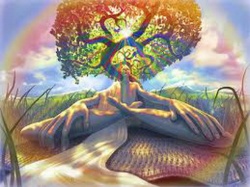Mimetic strategy of cognition in Buddhist Tantras by Vladimir Korobov
The strategy of cognition presented in Sarvāstivāda Abhidharma is pointed at the deconstruction of gnosiological determinants (avidyā, prapañca) that are responsible for the persistent generation of a defective and Suffering world of living beings. Total cessation of these gnosiological determinants results in nirupadhiśeṣa Nirvāṇa - Nirvāṇa without residual formations of mind and Body – and leads to an unconditional world that stands apart from the customary environment that is open to our mutual experience. The existence of two opposite states of being (Saṃsāra – Nirvāṇa) requires a transition associated with a system of moral renunciations and epistemological declinations.
In Prajñāpāramitā literature and later in works of Nāgārjuna, the “transitional model” is overlaid by another, non-dualistic disposition of Saṃsāra and Nirvāṇa attended by a different paradoxical strategy of cognition.
In Bodhicittavivaraṇa, verse 21, Nāgārjuna says:
- ““It’s the sameness of the object that functions,” [if asserted],
- Is this not like being harmed in a dream?
- Between the dream and wakeful state there is no difference
- Insofar as the functioning of things is concerned[1].”
Also in Yuktiṣaṣṭikā we read:
- “Existence and Nirvāṇa: These two are not [really] to be found. [Instead,] Nirvāṇa [may be] defined as the thorough knowledge of existence” (Lindtner, 1986, p. 74-75).
The Pañcaviṃśatisāhasrika-Prajñāparamitā states:
- “Coursing in the baseless, he (Bodhisattva, V.K.) sees all dharmas as contained in this perfection of Wisdom, and yet he does not apprehend those dharmas. And why? Because these dharmas on the one hand and that perfection of Wisdom on the other are not two nor divided. And why? Because there is no differentiation between these dharmas. All dharmas are undifferentiated because they have been identified with the Dharma-element (dharmadhātu), with suchness (tathatā), with reality limit (bhūtakoi)” (Conze, 1979, p. 628).
Though these approaches seem different, they both are “based on the general Buddhist notion that the actual soteriological breakthrough comes in the form of an intellectual event, gnosis and not an emotional one” (Wangchuk, 2007, p.199). In each intellectual event, consciousness (Vijñāna) is indispensably involved, but consciousness arises dependent on avidyā, influenced by prapañca and vikalpa, and it is constantly changing. It must be stopped, radically transformed or replaced by some other instrument of cognition to ensure the vision of things as they really are (vidyā).
In Tantric Buddhism the disposition of Saṃsāra and Nirvāṇa is similar to the disposition given in the Pāramitānayana, but instead of analysis of the true nature of phenomena as an instrument of cognition, Tantric Buddhism offers specific cognition techniques and specific understandings of ethical prescriptions.
Two types of successive reduction are peculiar to Buddhist Philosophy. Ontic representation of reality in general (as existence or as being in abstracto) is reduced to the present spacing of diverse things. Later this disposition of present things is reduced to a homogeneous, quantum field of dharmas -- dharmadhātu (chos dbyings). Any elementary event is a combination of at least three quanta: one of six internal powers (adhyātma-āyatana), which corresponds to the one of six external bases (bhāya-āyatana), and one of the six consciousness (Vijñāna). These quanta really become dharmas (carriers of quality) only after being involved in a composition. In other words, elements that are neutral and devoid of any characteristics become something (eye consciousness, for example) when they keep a definite “place” or “stand”, i.e. they are topologically conditioned. I want to say that a quantum (Dharma) possesses a definite quality, becomes differentiating consciousness, and becomes an external product of perception or sense abilities only within a temporal (strictly speaking, a momentary) composition. The composition itself is only a conventionality; the very existence of any composition may be established only from within the composition, because an agent (kartṛ) and enjoyer (bhoktṛ) appears only within the composition, mistakenly establishing himself as an external observer whereas he is always a participant. Accurately speaking, an observer as a person or “I” (gang zag, bdag) corresponds to the imaginary nature of reality (kun brtags, parikalpita), the interdependence of dharmas in composition corresponds to the dependent nature of reality (gzhan dbang, paratantra), and the grained field of uncombined dharmas-quanta corresponds to the essential nature of reality (yongs grub, pariniṣpanna)[2] . What is at issue is not three different realities, but three strata of a single fundamental reality as it is described in the third chapter of Madhyāntavibhāga.
We can see that the appearance of subject-object duality is not a construction of Citta (sems). An element that is playing a role of Citta in the structure of temporal dharmic composition undoubtedly is of great importance, but it is only a role (or a topological function); besides this “role” would be hardly possible without other elements of the composition on their own. Citta or mentality being active (sems pa, cetanā) provides awareness and discrimination (rnam par shes pa, Vijñāna) and continuity (yid, manas). Discrimination and continuity together with other elements in composition generate an event with a conditional “center” mistakenly taken for “I.” Bodhicitta, being a strategy of cognition, in turn, emphasizes a fundamental role of joint participation, removing “topological” deformation of the quantum field of dharmas caused by “I.” In this world filled with intentional phenomena, consciousness is always trying to make its way towards something that is not itself. It follows from understanding that each act of perception is not an act of passive data accessing, but rather is a masked question aimed at something that maybe belongs to the reality other than a reality of consciousness itself. This question is based on a distrust of the reality of the world of phenomena. The eliminating of this distrust is proved by cultivating total acceptance of the Other in all its manifestations. The series of these acceptances are called pāramitās. The acceptance in the form of giving of oneself (Dāna pāramitā ), the acceptance in the form of discipline and proper conduct (śīla pāramitā), the acceptance in the form of patience (kṣānti pāramitā), the acceptance in the form of effort and vigor (Vīrya pāramitā), the acceptance in the form of meditation (Dhyāna pāramitā) and finally prajñā pāramitā - an established acceptance in the form of identity. Thus Bodhicitta is the subsurface work of the consciousness pointed at eliminating the distrust of reality of the locus of the Other. The five worldly pāramitās are strategies for approaching the Other, and the sixth pāramitā is the complete consentaneity of the subject of apprehension and the object of apprehension.
It is necessary to note that each of the activities presented by pāramitās has its own recipient, or receiver (i.e. multiple forms of the Other). The question is to whom or to where is the activity of the sixth pāramitā addressed. This tricky pāramitā has no receiver or recipient. The absence of recipient has a justifiable reason: it simply doesn’t exist. Final direct perceiving of this fact shatters consciousness, the individuality disappears and becomes all phenomena at the same time.
As we know, Compassion (karuṇā), an altruistic attitude, forms the root of Bodhicitta, and Bodhicitta becomes a guiding principle for bodhisattvas in Mahāyāna Buddhism. But why in a system substantially rooted in epistemology did Compassion become so important? Is it simply connected to the traditionally built framework of ethical-moral discipline (śīla) or is there another explanation? The very act of knowing as well as acts of behavior presuppose the availability of the Other (other entities, other phenomena, other minds). What is “the Other”[3] from the point of view of the union of knower and known? Nagarjuna stated in Catuḥstava:
- “When (someone) cognizes (something) as born or unborn, present or gone, bound or liberated (then) he maintains duality (dvaya) (and consequently) does not know the truth (tattva)” (Lindtner, p.148-9). As Kamalaśīla writes commenting on Vairocana’s verses: “since Skandhas, dhātu and āyatana are devoid of their self-identity, then mind is totally free from being an apprehended object or being an apprehending subject. If mind does not exist like an object of apprehension, then it also does not exist like a subject of apprehension” (See Apendix).
In the act of cognition, this ultimate reality appears as conventional reality, which presumes the existence of the Other. It is important to note that the ultimate reality is not derivable from the conventional, for the circle of Saṃsāra is endless and closed. There is no transition or passage from conventional to ultimate reality. This is why the way of Tantra, if compared with the Pāramitāyana, is conceded to be easier: it is for the nonobscured, and it has many skillful methods, etc.[4] The Pāramitāyana is a strategy of approaching ultimate reality, but this approaching may be dragged out to infinity, because the movement from Saṃsāra to ultimate reality is crowded by a multitude of phenomena and events that require permanent and careful analytical examination. Thereby, it is very difficult to reach ultimate reality in any other way than to reproduce or copy an ultimate reality that is a unity of Emptiness and Compassion within conventional existence. But how exactly may ultimate reality be reproduced within Saṃsāra? I assert that there is only one way to reproduce it: to imitate it (mimesis) within conventional reality.
As I see it, the imitation may be established 1) by content and 2) by form. The ultimate union by content corresponds to the five wordly pāramitās, where conventional boddhicita (saṃvṛtibodhicitta, kun rdzob kyi byang chub kyi sems), which is Compassion for the Other and the intention to liberate others from Suffering, is a model of ultimate Bodhicitta (pāramārthikabodhicitta, don dam pa’i byang chub kyi sems), which is nonduality, ÷ūnyatā and gnosis (ye shes). The five wordly pāramitās are five different forms of acceptance of the Other, that is, they compose the very essence of Compassion.
The ultimate union by form corresponds to deity yoga (lha’i mgnong rtogs, literally, “realization of deity”). The very act of imitation has no moral coloring, just as a mirror reflects without any moral content. Only the precise reproduction of a given model by the individual totality – Body, speech and mind – is of great importance here.
Thereby, indivisible union, being out of reach of cognition, is a prototype for the combination of ethics and ritual in Tantric Buddhism. In this case, Bodhicitta as a strategy of cognition may be understood to be a mimesis or imitation (passion for imitation) of ultimate union in Saṃsāra by different means. Bodhicitta is here something that is impossible to understand or reach epistemologically but is possible to re-present. Sophisticated techniques and the rules of this re-presentation or mimesis of Bodhicitta within different levels of human existence (spiritual and ritual) are described in detail in different Sādhanās. Different commentaries by the Ārya and Jñānapāda traditions of the Guhyasamāja cycle explain in detail the most difficult points of this mimetic strategy of cognition. These texts do not provide us with any new knowledge; they describe a succession of matrix elements that are patterns for organizing one’s consciousness. Thereby, the Bodhicitta in Mantrayāna is a strategy of cognition, but this type of cognition is based on the will to imitate of ultimate reality. It may be called a strategy of mimesis, where all acts of perceiving result in a new being rather than in a new knowledge.
Footnotes
- ↑ don mchungs pa yis don byed pa
rmi lam gnod pa bzhin min nam
rmi lam sad pa’i gnas skabs la
don byed pa la khyad par med
(Ācārya Gyeltsen Namdol, 1991, p. 18) - ↑ In this connection it looks unreasonable to accuse Yogācāra of being an idealistic philosophy. Like Mādhyamaka, Yogācāra reveals the true nature of reality. Following a Doctrine of Dependent arising, Yogācāra philosophers simply couldn’t emphasize only one topological constituent of a compound event; they just emphasized the multilayer nature of reality and expansive role (prapañca, spros pa) of discriminative thought (vikalpa, rtog pa). “The statement that the tripe world is mind-only (cittamātra) simply means that for the unenlightened person what he or she takes to be reality is in fact nothing but mind and its concomitants (cittacaitta). The enlightened being on the other hand sees things as they are (yathābhūtam)” (Harris, 1991, p. 82).
- ↑ Different considerations on “Same” and “the Other” may be found in works of Jacques Lacan, Emmanuel Lévinas, Slavoj Žižek and other modern thinkers. Lacan, for instance, puts a Tantric question: “A geometry implies the heterogeneity of locus, namely that there is a locus of the Other. Regarding this locus of the Other, of one sex as Other, as absolute Other, what does the most recent development in topology allow us to posit?”
- ↑ About the superiority of mantra over Sūtra, see the chapter “The Difference Between Sūtra and Mantra” in Hopkins, J., 2008.
Source
Author: Vladimir Korobov - Vilnius University, Lithuania



